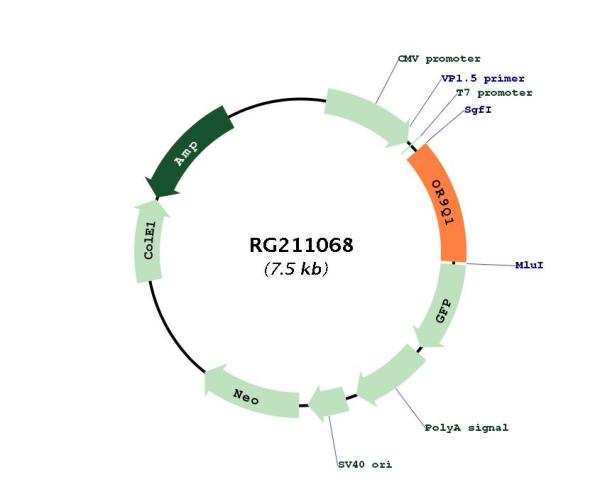OR9Q1 (NM_001005212) Human Tagged ORF Clone
CAT#: RG211068
- TrueORF®
OR9Q1 (tGFP-tagged) - Human olfactory receptor, family 9, subfamily Q, member 1 (OR9Q1)
ORF Plasmid: DDK
Lentiviral Particles: DDK DDK w/ Puro mGFP mGFP w/ Puro
AAV Particle: DDK
"NM_001005212" in other vectors (6)
Specifications
| Product Data | |
| Type | Human Tagged ORF Clone |
| Tag | TurboGFP |
| Symbol | OR9Q1 |
| Vector | pCMV6-AC-GFP |
| E. coli Selection | Ampicillin (100 ug/mL) |
| Mammalian Cell Selection | Neomycin |
| Sequence Data |
>RG211068 representing NM_001005212
Red=Cloning site Blue=ORF Green=Tags(s) TTTTGTAATACGACTCACTATAGGGCGGCCGGGAATTCGTCGACTGGATCCGGTACCGAGGAGATCTGCC GCCGCGATCGCC ATGGCAGAGATGAACCTCACCTTGGTGACCGAGTTCCTCCTTATTGCATTCACTGAATATCCTGAATGGG CACTCCCTCTCTTCCTCTTGTTTTTATTTATGTATCTCATCACCGTATTGGGGAACTTAGAGATGATTAT TCTGATCCTCATGGATCACCAGCTCCACGCTCCAATGTATTTCCTTCTGAGTCACCTCGCTTTCATGGAC GTCTGCTACTCATCTATCACTGTCCCCCAGATGCTGGCAGTGCTGCTGGAGCATGGGGCAGCTTTATCTT ACACACGCTGTGCTGCTCAGTTCTTTCTGTTCACCTTCTTTGGTTCCATCGACTGCTACCTCTTGGCGCT CATGGCCTATGACCGCTACTTGGCTGTGTGCCAGCCCCTGCTTTATGTCACCATCCTGACACAGCAGGCC CGCTTGAGTCTTGTGGCTGGGGCTTACGTTGCTGGTCTCATCAGTGCCTTGGTGCGGACAGTCTCAGCCT TCACTCTCTCCTTCTGTGGAACCAGTGAGATTGACTTTATTTTCTGTGACCTCCCTCCTCTGTTAAAGTT GACCTGTGGGGAGAGCTACACTCAAGAAGTGCTGATTATTATGTTTGCCATTTTTGTCATCCCTGCTTCC ATGGTGGTGATCTTGGTGTCCTACCTGTTTATCATCGTGGCCATCATGGGGATCCCTGCTGGAAGCCAGG CCAAGACCTTCTCCACCTGCACCTCCCACCTCACTGCTGTGTCACTCTTCTTTGGTACCCTCATCTTCAT GTACTTGAGAGGTAACTCAGATCAGTCTTCGGAGAAGAATCGGGTAGTGTCTGTGCTTTACACAGAGGTC ATCCCCATGTTGAATCCCCTCATCTACAGCCTGAGGAACAAGGAAGTGAAGGAGGCCCTGAGAAAAATTC TCAATAGAGCCAAGTTGTCC ACGCGTACGCGGCCGCTCGAG - GFP Tag - GTTTAA >RG211068 representing NM_001005212
Red=Cloning site Green=Tags(s) MAEMNLTLVTEFLLIAFTEYPEWALPLFLLFLFMYLITVLGNLEMIILILMDHQLHAPMYFLLSHLAFMD VCYSSITVPQMLAVLLEHGAALSYTRCAAQFFLFTFFGSIDCYLLALMAYDRYLAVCQPLLYVTILTQQA RLSLVAGAYVAGLISALVRTVSAFTLSFCGTSEIDFIFCDLPPLLKLTCGESYTQEVLIIMFAIFVIPAS MVVILVSYLFIIVAIMGIPAGSQAKTFSTCTSHLTAVSLFFGTLIFMYLRGNSDQSSEKNRVVSVLYTEV IPMLNPLIYSLRNKEVKEALRKILNRAKLS TRTRPLE - GFP Tag - V |
| Restriction Sites |
SgfI-MluI
Cloning Scheme for this gene
Plasmid Map

|
| ACCN | NM_001005212 |
| ORF Size | 930 bp |
| OTI Disclaimer | The molecular sequence of this clone aligns with the gene accession number as a point of reference only. However, individual transcript sequences of the same gene can differ through naturally occurring variations (e.g. polymorphisms), each with its own valid existence. This clone is substantially in agreement with the reference, but a complete review of all prevailing variants is recommended prior to use. More info |
| OTI Annotation | This clone was engineered to express the complete ORF with an expression tag. Expression varies depending on the nature of the gene. |
| Product Components | The ORF clone is ion-exchange column purified and shipped in a 2D barcoded Matrix tube containing 10ug of transfection-ready, dried plasmid DNA (reconstitute with 100 ul of water). |
| Reconstitution | 1. Centrifuge at 5,000xg for 5min. 2. Carefully open the tube and add 100ul of sterile water to dissolve the DNA. 3. Close the tube and incubate for 10 minutes at room temperature. 4. Briefly vortex the tube and then do a quick spin (less than 5000xg) to concentrate the liquid at the bottom. 5. Store the suspended plasmid at -20°C. The DNA is stable for at least one year from date of shipping when stored at -20°C. |
| Reference Data | |
| RefSeq | NM_001005212.2, NP_001005212.1 |
| RefSeq Size | 2519 bp |
| RefSeq ORF | 933 bp |
| Locus ID | 219956 |
| UniProt ID | Q8NGQ5 |
| Cytogenetics | 11q12.1 |
| Protein Families | Transmembrane |
| Protein Pathways | Olfactory transduction |
| Gene Summary | Olfactory receptors interact with odorant molecules in the nose, to initiate a neuronal response that triggers the perception of a smell. The olfactory receptor proteins are members of a large family of G-protein-coupled receptors (GPCR) arising from single coding-exon genes. Olfactory receptors share a 7-transmembrane domain structure with many neurotransmitter and hormone receptors and are responsible for the recognition and G protein-mediated transduction of odorant signals. The olfactory receptor gene family is the largest in the genome. The nomenclature assigned to the olfactory receptor genes and proteins for this organism is independent of other organisms. [provided by RefSeq, Jul 2008] |
Documents
| Product Manuals |
| FAQs |
| SDS |
Resources
Other Versions
| SKU | Description | Size | Price |
|---|---|---|---|
| RC211068 | OR9Q1 (Myc-DDK-tagged)-Human olfactory receptor, family 9, subfamily Q, member 1 (OR9Q1) |
USD 300.00 |
|
| RC211068L1 | Lenti ORF clone of Human olfactory receptor, family 9, subfamily Q, member 1 (OR9Q1), Myc-DDK-tagged |
USD 600.00 |
|
| RC211068L2 | Lenti ORF clone of Human olfactory receptor, family 9, subfamily Q, member 1 (OR9Q1), mGFP tagged |
USD 600.00 |
|
| RC211068L3 | Lenti ORF clone of Human olfactory receptor, family 9, subfamily Q, member 1 (OR9Q1), Myc-DDK-tagged |
USD 600.00 |
|
| RC211068L4 | Lenti ORF clone of Human olfactory receptor, family 9, subfamily Q, member 1 (OR9Q1), mGFP tagged |
USD 600.00 |
|
| SC300850 | OR9Q1 (untagged)-Human olfactory receptor, family 9, subfamily Q, member 1 (OR9Q1) |
USD 330.00 |
{0} Product Review(s)
Be the first one to submit a review






























































































































































































































































 Germany
Germany
 Japan
Japan
 United Kingdom
United Kingdom
 China
China

